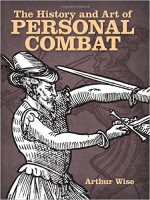“From the moment a girl gets to be full-grown, the very first thing she learns
When two men go out to face each other, only one returns.”-- Gene Pitney, The Man Who Shot Liberty Valance
Though opinions vary, the most recent revival of academic and practical interest in duelling started about two decades ago. This does not imply that there was no previous interest in historical swordplay since the 1910 passing of Captain Hutton, the famed Victorian officer who is credited with reviving the art of fencing.
Forty-five years ago, Wise wrote The History and Art of Personal Combat more as a social scientist, vice a swordsman. He was interested in trying to determine the how and why of individuals being driven to fight, often to the death. This was not part of an army or gang, but mano-a-mano. A true duel. His thesis? That duels were fought only for personal gain. The practice was frowned upon by most authorities, since the resulting violence was exercised outside of the control of the state and, for the most part, there was no benefit from the results. Through an understanding of duels, Wise believes, there comes the potential for intervening in or mitigating individual fights. This prevents further violence within modern society.
Wise's History may be sword-centric but the work is not sword-exclusive. His work is much more a survey that traces the development and theory of personal combat through the formality of the sword fight. With modern methods of commando raids that include the use of rifles, handguns, and fighter planes.
HEMA's interest in the Work of Wise should be peaked by his statement “more men have gone to their deaths in personal combat with the sword than with all other weapons put together.” In this case, the sword includes broadswords, short swords, longswords, rapiers, and daggers – all of which are depicted in generous groupings of photographs, engravings, and assorted art pieces.
‘History and Art’ is a readable, well-supported, and wide-ranging survey of the art of Renaissance swordplay. The same as it was known a half century ago. What it is not useful to those that want to understand how medieval swordplay was used in judicial duels, tourneys, or any other affray that might have happened between two men-at-arms. Manuscripts such as I.33 and Fiore dei Liberi might never have existed, much less the other lesser known works of Döbringer, et al. Medieval swordplay as depicted by Wise is the individual experience and accumulated tricks of wily veterans. This is not attributable to any ‘system’ of instruction nor learning.
That said, for HEMA practitioners, this is a useful (albeit dated) introduction of who’s who (and what is what) at least within the Renaissance sword world.
Fencing as we practice it started when armour became less effective because of the development of firearms. Fighters removed the heavy metal and began to develop, practice, and record proper swordplay. Wise credits the Germans with the first practical fight book and Grassi with the first effective use of the point. He also give's Agrippa points for developing ‘gymnastic’ swordplay and Capo Ferro the nod for the straight ‘back and forth’ movement of rapier fighting. Spanish Destreza gets a short mention as being a ‘complex dance’, but Wise does admit that there must have been something in the system. Practical combat advice is quoted from the Scotsman Sir William Hope that the duellist needs to rely on actual practice against a skilled opponent – not theory. As well that practice must happen with all weapons at hand, indoors and out, in good weather and bad. Fellow Scotsman Donald McBane comes in for accolades for his approach to duels; to do what you have to at all times to win. McBane’s approach to sword fighting is perhaps best summed up for modern times by General James Mattis, USMC.
The decline of renaissance swordplay is attributed to late 1780 small-sword practice in salles. This is when actually cutting and bruising your training opponent was frowned on, and practice for combat gave way to gentlemanly ‘touches’.
We don’t think that Wise found the answer to ‘why do men duel’ in a way that would allow society to prevent current fighting in society. Not that much of it resembles the formal sword duel of past times. And ‘yes’, the historical swordplay there in now ‘dated’ as knowledge of art has progressed with more people practicing the art, and discussing it, in semi-professional internet venues. But where the value of ‘Personal Combat’ continues to be unchallenged is as an inexpensive, richly illustrated overview of renaissance swordplay, swordfighters, and sword history. The book is still useful -- and available in the Academie Duello Library.
Work Cited
1. Wise, Arthur. The History and Art of Personal Combat. Mineola NY: Dover Publications Inc., 2014.
